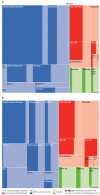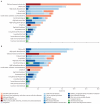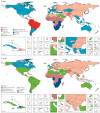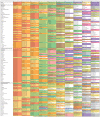Global, regional, and national comparative risk assessment of 79 behavioural, environmental and occupational, and metabolic risks or clusters of risks in 188 countries, 1990-2013: a systematic analysis for the Global Burden of Disease Study 2013
- PMID: 26364544
- PMCID: PMC4685753
- DOI: 10.1016/S0140-6736(15)00128-2
Global, regional, and national comparative risk assessment of 79 behavioural, environmental and occupational, and metabolic risks or clusters of risks in 188 countries, 1990-2013: a systematic analysis for the Global Burden of Disease Study 2013
Abstract
Background: The Global Burden of Disease, Injuries, and Risk Factor study 2013 (GBD 2013) is the first of a series of annual updates of the GBD. Risk factor quantification, particularly of modifiable risk factors, can help to identify emerging threats to population health and opportunities for prevention. The GBD 2013 provides a timely opportunity to update the comparative risk assessment with new data for exposure, relative risks, and evidence on the appropriate counterfactual risk distribution.
Methods: Attributable deaths, years of life lost, years lived with disability, and disability-adjusted life-years (DALYs) have been estimated for 79 risks or clusters of risks using the GBD 2010 methods. Risk-outcome pairs meeting explicit evidence criteria were assessed for 188 countries for the period 1990-2013 by age and sex using three inputs: risk exposure, relative risks, and the theoretical minimum risk exposure level (TMREL). Risks are organised into a hierarchy with blocks of behavioural, environmental and occupational, and metabolic risks at the first level of the hierarchy. The next level in the hierarchy includes nine clusters of related risks and two individual risks, with more detail provided at levels 3 and 4 of the hierarchy. Compared with GBD 2010, six new risk factors have been added: handwashing practices, occupational exposure to trichloroethylene, childhood wasting, childhood stunting, unsafe sex, and low glomerular filtration rate. For most risks, data for exposure were synthesised with a Bayesian meta-regression method, DisMod-MR 2.0, or spatial-temporal Gaussian process regression. Relative risks were based on meta-regressions of published cohort and intervention studies. Attributable burden for clusters of risks and all risks combined took into account evidence on the mediation of some risks such as high body-mass index (BMI) through other risks such as high systolic blood pressure and high cholesterol.
Findings: All risks combined account for 57·2% (95% uncertainty interval [UI] 55·8-58·5) of deaths and 41·6% (40·1-43·0) of DALYs. Risks quantified account for 87·9% (86·5-89·3) of cardiovascular disease DALYs, ranging to a low of 0% for neonatal disorders and neglected tropical diseases and malaria. In terms of global DALYs in 2013, six risks or clusters of risks each caused more than 5% of DALYs: dietary risks accounting for 11·3 million deaths and 241·4 million DALYs, high systolic blood pressure for 10·4 million deaths and 208·1 million DALYs, child and maternal malnutrition for 1·7 million deaths and 176·9 million DALYs, tobacco smoke for 6·1 million deaths and 143·5 million DALYs, air pollution for 5·5 million deaths and 141·5 million DALYs, and high BMI for 4·4 million deaths and 134·0 million DALYs. Risk factor patterns vary across regions and countries and with time. In sub-Saharan Africa, the leading risk factors are child and maternal malnutrition, unsafe sex, and unsafe water, sanitation, and handwashing. In women, in nearly all countries in the Americas, north Africa, and the Middle East, and in many other high-income countries, high BMI is the leading risk factor, with high systolic blood pressure as the leading risk in most of Central and Eastern Europe and south and east Asia. For men, high systolic blood pressure or tobacco use are the leading risks in nearly all high-income countries, in north Africa and the Middle East, Europe, and Asia. For men and women, unsafe sex is the leading risk in a corridor from Kenya to South Africa.
Interpretation: Behavioural, environmental and occupational, and metabolic risks can explain half of global mortality and more than one-third of global DALYs providing many opportunities for prevention. Of the larger risks, the attributable burden of high BMI has increased in the past 23 years. In view of the prominence of behavioural risk factors, behavioural and social science research on interventions for these risks should be strengthened. Many prevention and primary care policy options are available now to act on key risks.
Funding: Bill & Melinda Gates Foundation.
Copyright © 2015 Elsevier Ltd. All rights reserved.
Figures










Comment in
-
How can we reduce the global burden of disease?Lancet. 2015 Dec 5;386(10010):2235-7. doi: 10.1016/S0140-6736(15)00129-4. Epub 2015 Sep 11. Lancet. 2015. PMID: 26364543 No abstract available.
-
Risk factors: Contribution of low GFR to the global burden of disease.Nat Rev Nephrol. 2015 Nov;11(11):630. doi: 10.1038/nrneph.2015.160. Epub 2015 Sep 29. Nat Rev Nephrol. 2015. PMID: 26416500 No abstract available.
-
Risk factors for neonatal disorders and the Global Burden of Disease.Lancet. 2016 Aug 6;388(10044):560-1. doi: 10.1016/S0140-6736(16)31212-0. Lancet. 2016. PMID: 27511778 No abstract available.
References
-
- Watts C, Cairncross S. Should the GBD risk factor rankings be used to guide policy? Lancet. 2012;380:2060–61. - PubMed
-
- Kim JY. Data for better health—and to help end poverty. Lancet. 2012;380:2055. - PubMed
-
- Chan M. From new estimates to better data. Lancet. 2012;380:2054. - PubMed
-
- Rehm J, Borges G, Gmel G, et al. The comparative risk assessment for alcohol as part of the Global Burden of Disease 2010 Study: what changed from the last study? Int J Alcohol Drug Res. 2013;2:1–5.
Publication types
MeSH terms
Grants and funding
- MC_U137686851/MRC_/Medical Research Council/United Kingdom
- 091758/WT_/Wellcome Trust/United Kingdom
- MC_U147585827/MRC_/Medical Research Council/United Kingdom
- UL1 TR001079/TR/NCATS NIH HHS/United States
- R01 ES021446/ES/NIEHS NIH HHS/United States
- RG/08/014/24067/BHF_/British Heart Foundation/United Kingdom
- MC_U147585819/MRC_/Medical Research Council/United Kingdom
- P30 ES000260/ES/NIEHS NIH HHS/United States
- MC_UP_A620_1014/MRC_/Medical Research Council/United Kingdom
- ES00260/ES/NIEHS NIH HHS/United States
- R0I ES021446/ES/NIEHS NIH HHS/United States
- T32 HD057822/HD/NICHD NIH HHS/United States
- ImNIH/Intramural NIH HHS/United States
- MR/K006525/1/MRC_/Medical Research Council/United Kingdom
- G0400491/MRC_/Medical Research Council/United Kingdom
- MR/L003120/1/MRC_/Medical Research Council/United Kingdom
- 099876/WT_/Wellcome Trust/United Kingdom
- RP-PG-0407-10184/DH_/Department of Health/United Kingdom
- UL1 TR001425/TR/NCATS NIH HHS/United States
- 092654/WT_/Wellcome Trust/United Kingdom
- MC_UU_12011/1/MRC_/Medical Research Council/United Kingdom
- 5T32HD057822/HD/NICHD NIH HHS/United States
- KL2 TR001088/TR/NCATS NIH HHS/United States
- MC_U147585824/MRC_/Medical Research Council/United Kingdom
LinkOut - more resources
Full Text Sources
Other Literature Sources
Medical
Miscellaneous

